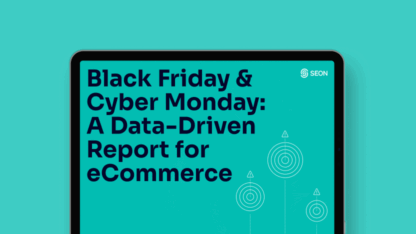The most dangerous fraudster in your system today might look just like your ideal customer. Welcome to the paradox of first-party fraud, also known as friendly fraud: an invisible drain on revenue, carried out by seemingly sincere shoppers who exploit lenient return policies, customer service loopholes and operational blind spots.
And it’s not a fringe issue. In 2024, retailers lost $103 billion to fraudulent returns, roughly 15 % of all returned merchandise. Even more telling: first-party fraud now accounts for 36 % of all global fraud cases, more than doubling in just a year.
In this guide, we’ll decode this subtle threat, exploring what first-party fraud really looks like, examining its tactics, revealing the red flags it leaves behind and outlining how businesses can fight back with precision, not guesswork.
First-party fraud is just one part of the evolving threat landscape. Discover the key trends, technologies and tactics shaping the future of online fraud in SEON’s 2025 Retail Fraud Report.
Read our report
What Is First-Party Fraud?
First-party fraud refers to incidents where a legitimate customer misrepresents a transaction, return or payment dispute to obtain financial gain. Unlike traditional fraud, which typically involves third parties exploiting stolen credentials, this type of deception is perpetrated by individuals with authentic identities, often using their real names, valid contact details and active customer accounts. It is, in essence, fraud from within.
The tactics vary. A customer might place an order and then falsely claim it never arrived, pocketing both the goods and a refund. Others may engage in “wardrobing”: returning items after visible use, often under the pretense that they were unsuitable or never worn. Perhaps most common is the chargeback: a dispute filed with a bank or payment provider to reverse a valid transaction, often under the guise of fraud or non-delivery. While these behaviors can be calculated, they sometimes arise from confusion or misunderstanding, such as a family member using a shared card or a customer forgetting about a purchase, giving rise to the term “friendly fraud”.
But make no mistake: whether intentional or not, the consequences are serious. Businesses bear the brunt in the form of lost revenue, inventory shrinkage, operational strain and rising dispute fees. Unlike more overt external fraud, first-party cases often lack clear malicious indicators. They blur the line between dishonesty and customer dissatisfaction, complicating efforts to challenge or even detect them.
The ambiguity makes first-party fraud one of the most difficult threats to isolate. In a digital-first era where trust, convenience and seamless returns are central to the customer experience, it slips easily through the cracks, masquerading as good-faith consumer behavior until the losses add up.
Red Flags: How to Identify First-Party Fraud in Action
Catching first-party fraud is like spotting a lie that’s just plausible enough to pass. It doesn’t always raise alarms individually, but when the patterns align, it paints a clear picture.
Here’s what to watch for when suspicion starts to outweigh trust:
- Fast orders from new accounts: Accounts that place high-ticket orders right after signing up or rush to request refunds often aren’t planning to stick around.
- Shared devices across multiple accounts: One device being used to create or log into several accounts? That’s a sign someone’s running a refund scheme at scale.
- No digital history: Emails and phone numbers with no associated online presence or activity can signal disposable contact info used to avoid detection.
- IP doesn’t match address: When an IP location doesn’t align with billing or shipping info (or changes frequently), it often points to VPNs or proxies masking identity.
- Prepaid or virtual card use: Transactions made with hard-to-trace payment methods (like prepaid, virtual or gift cards) deserve extra scrutiny, especially when paired with other risk factors.
- Excessive refund or return requests: Customers with an unusually high rate of returns or disputes may be gaming the system, particularly if the behavior is consistent across accounts.
Fraud detection isn’t about catching a single “gotcha” moment but rather about reading the pattern. When multiple signals appear together, it’s time to intervene before a refund becomes a repeat offense.
How to Stop First-Party Fraud Without Losing Customer Trust
Preventing first-party fraud is a balancing act: act too slowly and you bleed revenue, act too aggressively and you alienate legitimate customers. The solution is building smarter systems that flag abuse while keeping honest buyers moving smoothly. Here’s how to make that happen:
- Tighten return policies without adding friction: Require verified contact details like an email or SMS check before approving returns, and always cross-reference them with the original order. For high-risk goods, consider checking return weights to detect tampering or “bricking.”
- Replace cash refunds with store credit: Store credit discourages fraudsters who are only in it for the liquid cash. It also keeps value circulating within your business, not lost to abuse.
- Flag risky orders for review: Set up filters to flag orders from new accounts, high-risk items or mismatched billing and shipping info. These can be routed for manual review or escalated for extra verification.
- Analyze account behavior over time: Look for red flags in timing and activity, like accounts that request refunds shortly after signing up or show patterns of excessive returns, which often warrant a closer look.
- Track digital fingerprints and block repeat offenders: Detect devices, browsers or IP addresses used across multiple accounts and monitor for signs of proxy or emulator use. Reused devices or prepaid card BINs can signal an organized refund scheme.
- Verify the credibility of contact details: Low-quality or disposable email addresses and burner phones often have no digital footprint. Scoring them for reputation or associated activity can help spot suspicious accounts early.
- Use real-time fraud scoring and machine learning: Modern fraud engines can flag behavior based on dynamic signals and adapt as fraud patterns evolve, helping detect subtle abuse without punishing legitimate users.
- Train support teams to spot abuse: Ensure customer service knows how to distinguish between genuine issues and suspicious patterns. Friendly fraud often hides behind polite complaints until it becomes a recurring theme.
- Automate your chargeback defense: Push chargeback disputes directly to payment networks where possible and automate documentation for fast, consistent responses. Every win here discourages the next attempt.
How SEON Helps Combat First-Party Fraud
First-party fraud hides in plain sight, but SEON was built to spot what others miss. For retailers juggling rising return rates and rising fraud risk, our platform delivers the right kind of friction: invisible to honest customers and impossible for fraudsters to ignore.
SEON enriches every user interaction from the moment a buyer first visits your platform. At the heart of our solution is real-time digital footprint analysis: every email address, phone number and IP address is enriched to reveal crucial context, like whether a customer has an online history, if their phone number has ever been seen before or if their IP geolocation doesn’t match their shipping address.
Our device intelligence connects the dots between accounts and sessions, detecting when the same device or emulator is used to run multiple identities. That means you can spot repeat abusers long before their next “missing order” email hits your inbox.
SEON’s behavioral analytics go a step further, flagging risky patterns like refund loops, account hopping and suspicious order timelines. You can set up custom risk rules to automatically escalate edge cases or verify returns before they’re approved.
When refund abuse escalates into chargebacks, SEON helps you fight back faster. Our chargeback automation tool streamlines the dispute process with better evidence, fewer manual steps and higher win rates.
Fraud may evolve, but so does SEON. With adaptive machine learning, tailored risk scoring and flexible integrations, we help you stop first-party fraud at the source without turning everyday customers into suspects.
Looking Ahead
As digital commerce continues to grow, so too will the creativity and scale of first-party fraud. But with the right signals, smarter technology and a proactive strategy, businesses can shift from reactive loss recovery to real-time prevention. The fraud landscape may be evolving, but so are the tools to stay ahead of it.
Turn digital footprints into fraud signals, flag risks in real time, and automate chargeback defense, without adding customer friction. See how SEON stops retail fraud before it hits your bottom line.
Speak with an Expert









